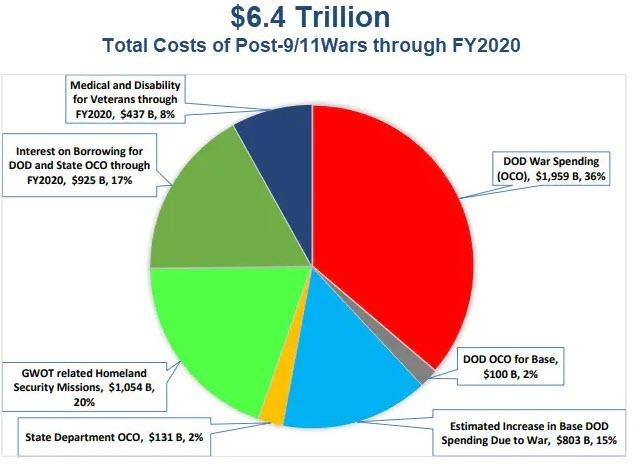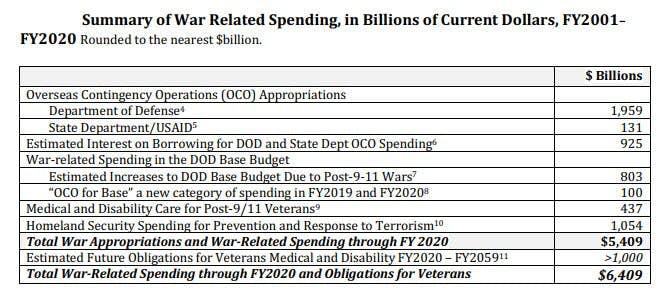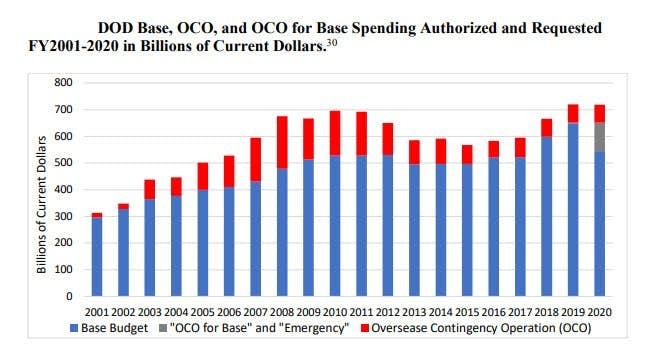6.4 Trillion Reasons To End America’s Forever Wars
Authored by Mike Shedlock via MishTalk,
Since 9/11, the cost of Forever War totals $6.4 Trillion and 801,000 killed including 335,000 dead civilians. For What?
Neta C. Crawford, Professor and Chair of the Department of Political Science at Boston University and a co-director of the Costs of War Project at Brown University calculates the [Cost of 20 Years of War].
Summary of War-Related Spending
Changing the Names of the Wars to Hide the Total
One potential barrier for civilians to understanding the total scale and costs of the post-9/11 wars is the changes in the naming of the wars. The US military designates main war zones in Afghanistan, Pakistan, Iraq, and Syria as named operations. The longest war so far, in Afghanistan and Pakistan, has had two names: Operation Enduring Freedom, designated the first phase of war in Afghanistan from October 2001; it was designated Operation Freedom’s Sentinel on 1 January 2015. The war in Iraq was designated Operation Iraqi Freedom from March 2003 to 31 August 2010, when it became Operation New Dawn. When the US began to fight in Syria and Iraq, the war was designated Operation Inherent Resolve. For ease of understanding, the costs are not labeled here by their OCO designation, but by major war zone — namely Afghanistan and Pakistan, and Iraq and later Iraq and Syria.
Hiding Was as Emergency Funding
OCO spending is considered emergency spending. Emergency appropriations for the DOD are not subject to the same detailed Congressional oversight and limits as regular, or “base” budget non-emergency appropriations, for costs that endure whether or not the US is at war.
Shifting Expenses to Exceed the Budget
In FY 2019, the Trump Administration made the practice of shifting emergency OCO appropriations into the base budget overt when it introduced new ways of categorizing the Department of Defense spending related to the Overseas Contingency Operations. Some of the funding that was previously designated for specific military operations has now been moved into a category called “OCO for Enduring Theater Requirements and Related Missions” and another, “OCO for Base Requirements.”
These changes are specifically and explicitly intended to get around Congressionally imposed limits on the base defense budget. The Department of Defense FY2020 request explicitly stated as much: “These base budget requirements are funded in the OCO budget due to limits on budget defense caps enacted in the Budget Control Act of 2011.”
War Veterans Medical Care and Disability Compensation
In 2018, there were 4.1 million post-9/11 war veterans, comprising about 21 percent of all veterans and 16 percent of all veterans served by the Department of Veterans Affairs (VA). The post-9/11 war veterans are, in general, less healthy than the veterans of previous wars. Advances in trauma and battlefield medicine, have meant that the veterans of these wars, also called Gulf War era II veterans, have survived to live with more serviceconnected disabilities than veterans of previous wars. These veterans, exposed to different field conditions and who often served multiple deployments, need more and different kinds of medical care than the veterans of previous wars and those costs will only rise.
How Many Died?
The American Conservative comments the Costs of Forever War: 335,000 Dead Civilians and $6.4 Trillion.
The amount of money spent on these wars cannot fully convey their sheer wastefulness. Wars are always expensive, and they usually end up being much more expensive than anyone anticipates at the beginning, but when those wars are unnecessary and useless it makes the exorbitant cost that much more sickening. The money and resources expended on almost twenty years of failed wars could have been put to any number of more productive uses. Instead, that vast sum has been poured down the drain. As it is, the U.S. has little or nothing to show for the massive malinvestment that it has made in fighting these wars. These wars have not made the U.S. more secure, they have created more enemies than they destroyed, and they have set fires in their respective regions that will take years to burn out. As staggering as the $6.4 trillion figure is, it doesn’t capture how ruinous these wars have been. The U.S. will continue to pay for these wars long after they are over in more ways than one.
A full reckoning of the costs of our wars has to include the hundreds of thousands dead, millions displaced, and the wreckage of multiple countries. These are the truly senseless losses that could have been avoided. The report details these costs as well:
The report, from Watson Institute of International and Public Affairs at Brown University, also finds that more than 801,000 people have died as a direct result of fighting. Of those, more than 335,000 have been civilians. Another 21 million people have been displaced due to violence.
The death and destruction that our wars inflict on the people living in these countries are rarely mentioned in our foreign policy debates, and these losses are almost never taken into consideration when thinking about the costs of these wars. That encourages U.S. politicians and policymakers to take a very cavalier approach to supporting the use of force in other parts of the world, and it allows them to escape accountability for the harm that these policies cause.
For the last twenty years, there has been no limit on what the U.S. would spend on foreign wars, and Congress and presidents of both parties have reliably thrown more money at the Pentagon to sustain these unwinnable wars. While there might be occasional griping about “waste, fraud, and abuse,” there has been no serious, consistent effort to rein in these wars or the military budget. There has been even less interest in grappling with the horrific human costs of our militarized foreign policy. That has to change, and it starts with demanding that the U.S. end its failed and open-ended wars abroad.
Drain the Swamp
Republicans argue for “Balanced Budgets” except of course when they hold the office of Presidency.
They refuse to fund the wars and military spending they demand.
Drain the Swamp my ass.
Anyone who expected Trump to “drain the swamp” was delusional.
If you disagree, please see “Peak Trump” by David Stockman: Book Review.
Art of Compromise
Compromise is nothing more than Republicans agreeing for more social spending as long as Democrats agree to more military spending.
Delusioned Democrats are just as bad if not much worse.
Please note AOC’s Green New Deal Pricetag of $51 to $93 Trillion vs. Cost of Doing Nothing.
There are no controls anywhere to stop the madness.
How Did this Happen?
The answer is easy.
In 1971, Nixon removed closed the gold window ending all deficit spending controls. This enabled Congress to spend at will, and nations in general to abandon all fiscal responsibility.
The result was a whopping $250 trillion in global debt.
I asked, $250 Trillion in Global Debt: How Can That Be Paid back?
The short answer is that it “won’t”. A currency crisis awaits, as noted in the above link.
Meanwhile, spending is more than a bit out of control, and will remain out of control until some sort of currency crisis settles the hash.
Tyler Durden
Thu, 11/21/2019 – 11:30
via ZeroHedge News https://ift.tt/35kVUsk Tyler Durden



